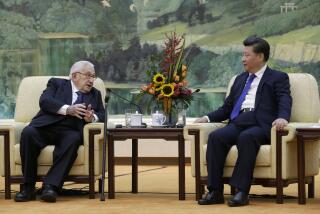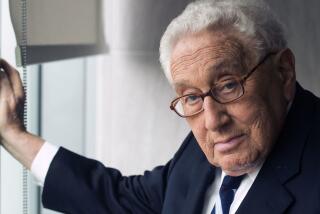When ‘the little ball moved the big ball’ four decades ago
- Share via
Tim Boggan is growing tired of the diplomacy involved in celebrating pingpong diplomacy.
In 1971, the table tennis historian was one of the first Americans to enter China since 1949. But he says the speeches commemorating the 40-year anniversary are full of “niceties” and “politeness” to the point that nobody listens.
So when Boggan rises to talk about his unlikely trip to China — he has done so six times this week — he delivers an original oration every time. At the Nixon Library in Yorba Linda on Thursday night, Boggan offered a candid and occasionally uncomfortable talk about his chance encounter with a “Chinese mystery man” who sought Boggan out simply to return his pen. Their 10-second conversation left a lasting impression.
Photos: Pingpong diplomats meet again
“I saw him as a person with integrity, a person who had dreams, who was solid for China and wanted absolutely the best for much more than himself,” Boggan said. “This guy is important, and I hardly saw him really. … But there was something there.”
Boggan, 80, thinks too much gets made of the matches credited with thawing U.S.-China relations. And yet, something about Boggan’s personal interaction with the Chinese diplomat has stuck with him all those years. Experts, diplomats and table tennis players alike seem to agree that sports competition breeds personal interaction, and such interaction can, in President Richard Nixon’s words, “change the world.”
On Friday the Richard Nixon Foundation commemorated the 40th anniversary of what became known as pingpong diplomacy — though the more formal name of the sport is table tennis. The day’s program featured two rematches between the Chinese and American players who initiated Sino-American relations using their paddles and feather-weight balls. A packed morning at the Nixon Library included everything from speeches to Chinese drum girl performances to high-level table tennis matches. Players signed autographs and one travel-study group from Beijing filled a third of the stands.
“It is the pingpong that got the two countries together,” said Qiu Shaofang, China’s consul general in Los Angeles. “It is a long story.”
The story begins in 1949, when the Communist Party of China drove nationalists to Taiwan and paved the way for Mao Tse-tung to establish the People’s Republic of China on the mainland. The United States refused to formally recognize the PRC, and the icy relationship between the countries became a major contributor to Cold War tension for decades. The United States and the PRC opposed each other in two wars, the U.S. placed a trading embargo on the PRC and staunchly defended the nationalist Chinese government in Taiwan.
“It’s hard for us to really understand just how little direct contact Americans and Chinese had with each other,” said Clayton Dube, associate director of USC’s U.S.-China Institute. “It was a place that was much talked about, and it was a place where the imagination ran wild.”
In the years leading up to 1971, however, leadership from both countries was sending signals that they might wish to normalize relations. Secret meetings were held in Warsaw in the 1950s, and before his presidency, Nixon had written that “China needs to be brought into the world community.”
So the stage was set for the 1971 World Table Tennis Championships in Japan, where the two teams initially met. One afternoon, Glenn Cowan missed the American team bus, and a Chinese player waved him onto the Chinese team bus. More than halfway into the ride, Zhuang Zedong moved up from his seat in the back to greet the American and presented Cowan with a silk portrait of the Huangshan Mountains. When the pair stepped off the bus together, photographers were there to meet them.
“Zedong broke the rules,” Dube said. “Chinese players were not supposed to be fraternizing with specifically American players. It’s a local guy who winds up on the bus in Tokyo and the senior person extends this gesture of friendship. It’s really quite remarkable.”
What happens next is unclear. But officials from both teams expressed interest in a visit, and an invitation and acceptance came quickly. On April 10, nine players plus officials, spouses and journalists crossed a bridge from Hong Kong to China. The group spent a week playing table tennis and sightseeing.
The visit paved the way for Henry Kissinger to conduct a secret visit to China in July, which set up Nixon’s historic visit in February 1972. The U.S. then formally recognized that there was only one China and thereby set the Taiwan question aside to normalize relations.
Nixon called it “the week that changed the world,” but Wei Wang remembers the words of Chairman Mao. She was a child in the early 1970s and says she doesn’t recall much about the events. But the former U.S. Olympian and current Westside Table Tennis Center instructor does remember one thing clearly.
“The prime minister said, ‘The little ball moved the big ball’ — a pingpong ball moved the earth,’ ” she said. “That was the metaphor. China opened up from that — from table tennis.”
The notion that sport could open a country seems outlandish on its face, but pingpong diplomacy is just one of several examples of sport influencing politics. Sports historian Richard Crepeau said the U.S. boycott of the 1980 Olympics in Moscow, and the Soviet Union’s rebuttal four years later in Los Angeles, served as strong national statements about foreign policy.
“Sport is so popular and so important around the world, using it can make a very direct and succinct point,” Crepeau said. “There is a conscious attempt by the American government to use sports in various aspects of foreign policy, and vice versa. … Sport and patriotism go together.”
Crepeau added that sports can also help humanize politicians. President George W. Bush’s affiliation with the Texas Rangers helped pad his image as an average Joe, and his first pitch at Yankee Stadium after Sept. 11, 2001, remains an iconic image in contemporary sports. Crepeau says that even Nixon used sports to soften his image. The former president was one of the first to send plays to football coaches and call locker rooms after a title game. Now President Obama broadcasts his NCAA tournament bracket every March.
Dube agrees that sports help humanize, and he applies this logic back to retired Chinese basketball player Yao Ming and tennis player Li Na.
“They are people with real personalities that are distinct,” Dube said. “They let us see enough of who they are that we feel we somehow know them, and that in knowing them, we discover a lot that we like. That is one of the magical things about sports.”
Ultimately, he says, sports’ ability to humanize is part of the reason pingpong diplomacy can work. An American can meet a Chinese on a bus. Or a historian can run into a diplomat intent on returning his pen.
“All of this works toward demystifying people,” Dube said. “Now, does it remove big political obstacles? Not at all. But it provides an easier context to talk about these things. We just are more comfortable with each other.”
Forty years after they first met, George Braithwaite is pretty comfortable playing China’s Liang Geliang. Still, the Hall of Fame American table tennis player, now 76, says he gets flustered by his opponent’s defensive strategy.
On Friday, Braithwaite and Geliang picked up their paddles again four decades after they first sized each other up on China’s mainland. Braithwaite lost again, 11-4.
“Nothing has changed in 40 years,” he said, chuckling.
twitter.com/mattstevenslat
More to Read
Go beyond the scoreboard
Get the latest on L.A.'s teams in the daily Sports Report newsletter.
You may occasionally receive promotional content from the Los Angeles Times.











